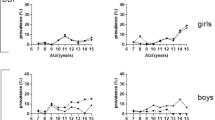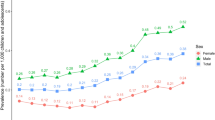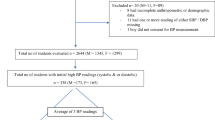Abstract
The European Society of Hypertension (ESH) and American Academy of Pediatrics (AAP) recently updated their childhood hypertension management guidelines. We aimed to compare the hypertension prevalence determined using the two aforementioned guidelines and Fourth Report in a national cohort study. This 4.6-year follow-up study included 4276 children who had participated in the China Health and Nutrition Study. At baseline and during a follow-up survey, hypertension was defined using the three guidelines. We calculated the pediatric hypertension prevalence in at least one survey and in both surveys as the number of participants identified as hypertensive in at least one survey or in both surveys divided by 4276, respectively. Using Mc Nemar’s test, we determined that the prevalence of pediatric hypertension differed significantly according to AAP vs. ESH guidelines and Fourth Report at the baseline (8.3% vs. 5.0% and 5.0%, respectively; reference, AAP; Ps < 0.001 for AAP vs. ESH guidelines and Fourth Report) and follow-up surveys (14.5% vs. 5.0% and 6.0%, respectively; reference, AAP; both Ps < 0.001), as well as among those detected with hypertension in at least one survey (21.0% vs. 9.4% and 10.4%, respectively; reference, AAP; both Ps < 0.001) and both surveys (1.8% vs. 0.5% and 0.6%, respectively; reference, AAP; both Ps < 0.001). We obtained similar results when using the three guidelines to define childhood elevated blood pressure. Our findings confirm the higher prevalence of pediatric hypertension using AAP guideline than those using ESH guideline and Fourth Report. Consequently, childhood hypertension management guidelines should be selected and used with caution.
This is a preview of subscription content, access via your institution
Access options
Subscribe to this journal
Receive 12 digital issues and online access to articles
$119.00 per year
only $9.92 per issue
Buy this article
- Purchase on Springer Link
- Instant access to full article PDF
Prices may be subject to local taxes which are calculated during checkout
Similar content being viewed by others
References
Dagenais GR, Leong DP, Rangarajan S, Lanas F, Lopez-Jaramillo P, Gupta R, et al. Variations in common diseases, hospital admissions, and deaths in middle-aged adults in 21 countries from five continents (PURE): a prospective cohort study. Lancet 2020;395:785–94.
Yusuf S, Joseph P, Rangarajan S, Islam S, Mente A, Hystad P, et al. Modifiable risk factors, cardiovascular disease, and mortality in 155722 individuals from 21 high-income, middle-income, and low-income countries (PURE): a prospective cohort study. Lancet 2020;395:795–808.
Chen X, Wang Y. Tracking of blood pressure from childhood to adulthood: a systematic review and meta-regression analysis. Circulation 2008;117:3171–80.
Taylor-Zapata P, Baker-Smith CM, Burckart G, Daniels SR, Flynn JT, Giacoia G, et al. Research Gaps in Primary Pediatric Hypertension. Pediatrics 2019;143:e20183517.
National High Blood Pressure Education Program Working Group on High Blood Pressure in Children and Adolescents. The Fourth Report on the diagnosis, evaluation, and treatment of high blood pressure in children and adolescents. Pediatrics 2004;114:555–76.
Lurbe E, Agabiti-Rosei E, Cruickshank JK, Dominiczak A, Erdine S, Hirth A, et al. European Society of Hypertension guidelines for the management of high blood pressure in children and adolescents. J Hypertens 2016;2016:1887–1920.
Flynn JT, Kaelber DC, Baker-Smith CM, Blowey D, Carroll AE, Daniels SR, et al. Clinical practice guideline for screening and management of high blood pressure in children and adolescents. Pediatrics 2017;140:e20171904.
Dong Y, Song Y, Zou Z, Ma J, Dong B, Prochaska JJ. Updates to pediatric hypertension guidelines: influence on classification of high blood pressure in children and adolescents. J Hypertens 2019;37:297–306.
Antolini L, Giussani M, Orlando A, Nava E, Valsecchi MG, Parati G, et al. Nomograms to identify elevated blood pressure values and left ventricular hypertrophy in a paediatric population: American Academy of Pediatrics Clinical Practice vs. Fourth Report/European Society of Hypertension Guidelines. J Hypertens 2019;37:1213–22.
Stabouli S, Redon J, Lurbe E. Redefining hypertension in children and adolescents: A review of the evidence considered by the European Society of Hypertension and American Academy of Pediatrics guidelines. J Hypertens 2020;38:196–200.
Popkin BM, Du S, Zhai F, Zhang B. Cohort profile: The China Health and Nutrition Survey‐monitoring and understanding socio‐economic and health change in China, 1989‐2011. Int J Epidemiol 2010;39:1435–40.
Fan H, Zhu Q, Medrano-Gracia P, Zhang X. Comparison of child adiposity indices in prediction of hypertension in early adulthood. J Clin Hypertens 2019;21:1858–62.
Kuczmarski RJ, Ogden CL, Guo SS, Grummer-Strawn LM, Flegal KM, Mei Z, et al. CDC Growth Charts for the United States: methods and development. Vital Health Stat 2000;2002:1–190.
National Center for Health Statistics. 2000 CDC growth charts: United States. http://www.cdc.gov/growthcharts/. Accessed 16 February 2020.
Sharma AK, Metzger DL, Rodd CJ. Prevalence and severity of high blood pressure among children based on the 2017 American Academy of Pediatrics Guidelines. JAMA Pediatr 2018;172:557–65.
Larkins NG, Teixeira-Pinto A, Kim S, Burgner DP, Craig JC. The population-based prevalence of hypertension and correlates of blood pressure among Australian children. Pediatr Nephrol 2019;34:1107–15.
Khoury M, Khoury PR, Dolan LM, Kimball TR, Urbina EM. Clinical implications of the revised AAP pediatric hypertension guidelines. Pediatrics 2018;142:e20180245.
Condren M, Carter J, Mushtaq N, Puckett S, Kezbers K, Sabet S, et al. The impact of new guidelines on the prevalence of hypertension in children: a cross-sectional evaluation. J Clin Hypertens 2019;21:510–5.
Yang L, Kelishadi R, Hong YM, Khadilkar A, Nawarycz T, Krzywińska-Wiewiorowska M, et al. Impact of the 2017 American Academy of Pediatrics Guideline on Hypertension Prevalence Compared With the Fourth Report in an International Cohort. Hypertension 2019;74:1343–48.
Luo B, Lin Y, Gao S, Lu Y, Zhao Y, Xie J, et al. Impact of updated pediatric hypertension criteria on prevalence estimates of hypertension among Chinese children. J Hum Hypertens. 2020. https://doi-org.ezp.lib.cam.ac.uk/10.1038/s41371-020-0370-0.
Di Bonito P, Valerio G, Pacifico L, Chiesa C, Invitti C, Morandi A, et al. Impact of the 2017 blood pressure guidelines by the American Academy of Pediatrics in overweight/obese youth. J Hypertens 2019;37:732–8.
Bell CS, Samuel JP, Samuels JA. Prevalence of hypertension in children. Hypertension 2019;73:148–52.
Du T, Fernandez C, Barshop R, Chen W, Urbina EM, Bazzano LA. Pediatric hypertension guidelines improve prediction of adult cardiovascular outcomes. Hypertension 2017;2019:1217–23.
Fan H, Hou D, Liu J, Yan Y, Mi J. Performance of 4 definitions of childhood elevated blood pressure in predicting subclinical cardiovascular outcomes in adulthood. J Clin Hypertens 2018;20:508–14.
Whelton PK, Carey RM, Aronow WS, Casey DE Jr, Collins KJ, Dennison Himmelfarb C, et al. 2017ACC/AHA/AAPA/ABC/ACPM/AGS/APhA/ASH/ASPC/NMA/PCNA guideline for the prevention, detection, evaluation, and management of high blood pressure in adults: executive summary: a report of the American College of Cardiology/American Heart Association Task Force on clinical practice guidelines. Hypertension 2018;71:1269–324.
The Task Force for the management of arterial hypertension of the European Society of Cardiology (ESC) and the European Society of Hypertension (ESH). ESC/ESH Guidelines for the management of arterial hypertension. Eur Heart J 2018;2018:3021–104.
Lande MB, Batisky DL. New American Academy of Pediatrics Hypertension Guideline. Hypertension 2019;73:31–2.
Blanchette E, Flynn JT. Implications of the 2017 AAP Clinical Practice Guidelines for Management of Hypertension in Children and Adolescents: a review. Curr Hypertens Rep. 2019;21:35.
Daniels SR. What is the prevalence of childhood hypertension?: it depends on the definition. JAMA Pediatr 2018;172:519–20.
Fan H, Liu Y, Zhang X. Validation of recommended definition in identifying elevated blood pressure in adolescents. J Clin Hypertens 2019;21:1343–49.
Acknowledgements
We thank the National Institute for Nutrition and Health, China Center for Disease Control and Prevention, Carolina Population Center, the University of North Carolina at Chapel Hill, the NIH, and the NIH Fogarty International Center for the support for the CHNS data collection and analysis files. This study was supported by the PhD Funding Program of North Sichuan Medical College (CBY18-QD02), the Key Subject Development Program of North Sichuan Medical College (NSMC-M-18-19), and Funding Program of Primary Health Development Research Center of Sichuan Province (SWFZ20-Q-045).
Author information
Authors and Affiliations
Contributions
HF conceptualized and designed the study, carried out the initial analyses, drafted the initial manuscript, and reviewed and revised the manuscript. XZ critically reviewed and revised the manuscript. Both authors approved the final manuscript as submitted.
Corresponding author
Ethics declarations
Conflict of interest
The authors declare that they have no conflict of interest.
Additional information
Publisher’s note Springer Nature remains neutral with regard to jurisdictional claims in published maps and institutional affiliations.
Supplementary information
Rights and permissions
About this article
Cite this article
Fan, H., Zhang, X. Difference in hypertension prevalence applying three childhood hypertension management guidelines in a national cohort study. J Hum Hypertens 35, 1038–1045 (2021). https://doi.org/10.1038/s41371-020-00447-7
Received:
Revised:
Accepted:
Published:
Issue Date:
DOI: https://doi.org/10.1038/s41371-020-00447-7



